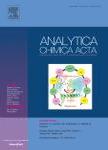版权所有:内蒙古大学图书馆 技术提供:维普资讯• 智图
内蒙古自治区呼和浩特市赛罕区大学西街235号 邮编: 010021

作者机构:Tongji Univ State Key Lab Pollut Control & Resources Reuse Coll Environm Sci & Engn Shanghai 200092 Peoples R China Shanghai Inst Pollut Control & Ecol Secur Shanghai 200092 Peoples R China
出 版 物:《ANALYTICA CHIMICA ACTA》 (分析化学学报)
年 卷 期:2024年第1317卷
页 面:342866页
核心收录:
学科分类:081704[工学-应用化学] 07[理学] 08[工学] 0817[工学-化学工程与技术] 070302[理学-分析化学] 0703[理学-化学]
基 金:National Natural Science Foundation of China (NSFC) Fundamental Research Funds for the Central Universities
主 题:Electrochemical immunosensor Antifouling Amphiphilic peptide Cardiac troponin I Human serum
摘 要:Background: Cardiac troponin I (CTnI) is demonstrated as one of the most promising disease biomarkers for early diagnosing acute myocardial infarction (AMI). To date, electrochemical immunosensors have been extensively studied in the field of cTnI determination. But highly accurate and sensitive cTnI detection by this method is still a challenge due to non-specific adsorption on electrode interfaces in complex human serum. As a result, it is necessary to develop an antifouling electrochemical immunosensor with high sensitivity for the detection of cTnI. Results: In this work, an antifouling electrochemical immunosensor was constructed based on vertically-aligned peptide layer consisting of Au nanoparticles (AuNPs) and amphiphilic CEAK16 peptide (CEAK16@AuNPs) for sensitive and accurate detection of cTnI in human serum. The vertically-aligned CEAK16@AuNPs interface provided a stable hydration layer originated from attraction of water molecules by amino acids on the hydrophilic side of the CEAK16, which effectively reduced non-specific adsorption and enhanced electron transfer rate. The cTnI immunosensor possessed great analytical performance with a wide range from 1 fg mL-1-1 to 1 mu g mL-1-1 and a low detection limit of 0.28 fg mL-1-1 (S/N = 3). Additionally, the proposed CEAK16@AuNPs sensing interface showed excellent long-term antifouling performance and electrochemical activity that preserved 80 % of the initial signal after 20-days exposure in human serum samples. Consequently, the cTnI immunosensor displayed excellent detection accuracy compared to clinical methods and owned good selectivity, stability and reproducibility. Significance: The development of this strategy provides a versatile tool for accurate quantitative cTnI analysis in real human serum, thus helping to achieve early AMI diagnosis effectively and holding the promising potentials for other immunosensor in disease diagnosis.